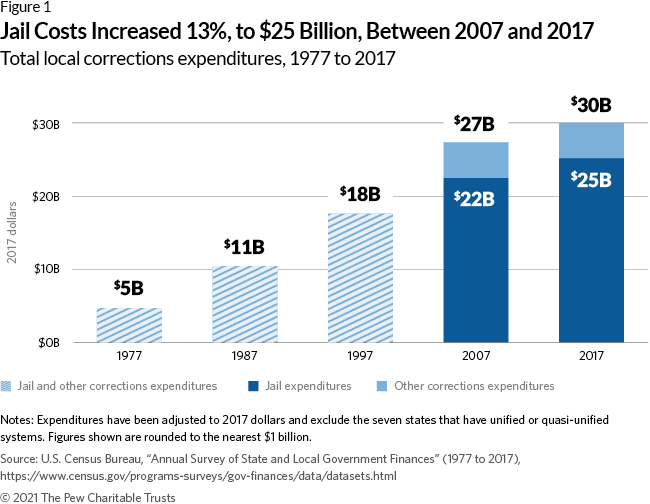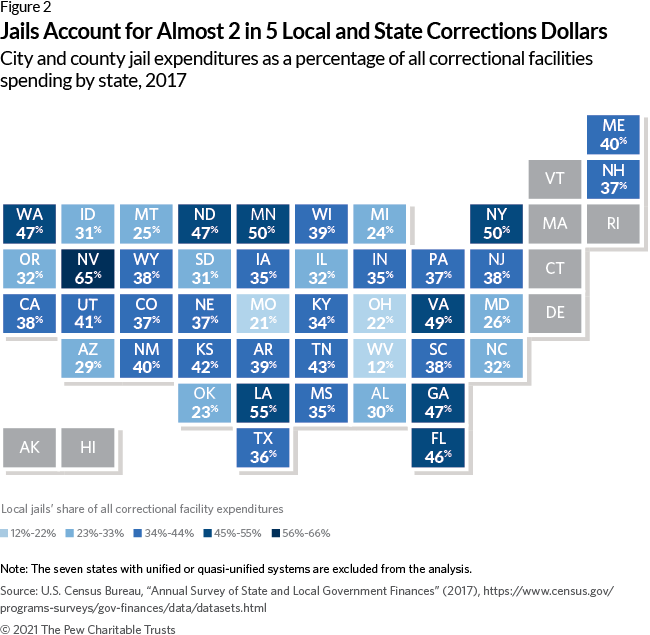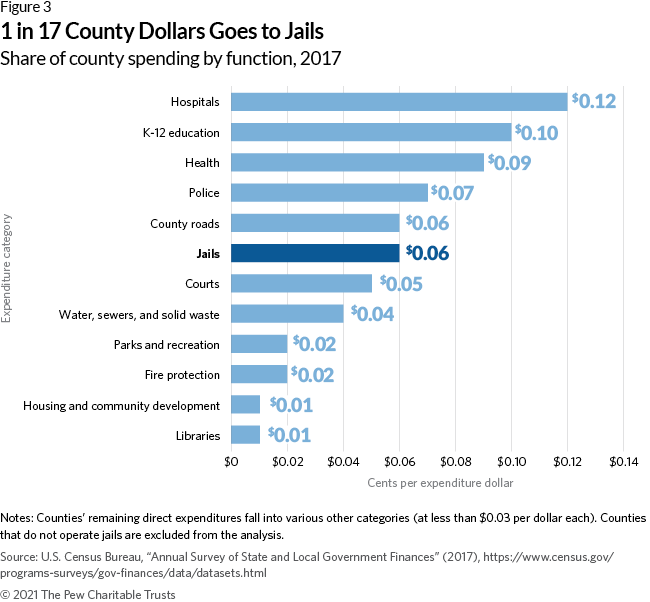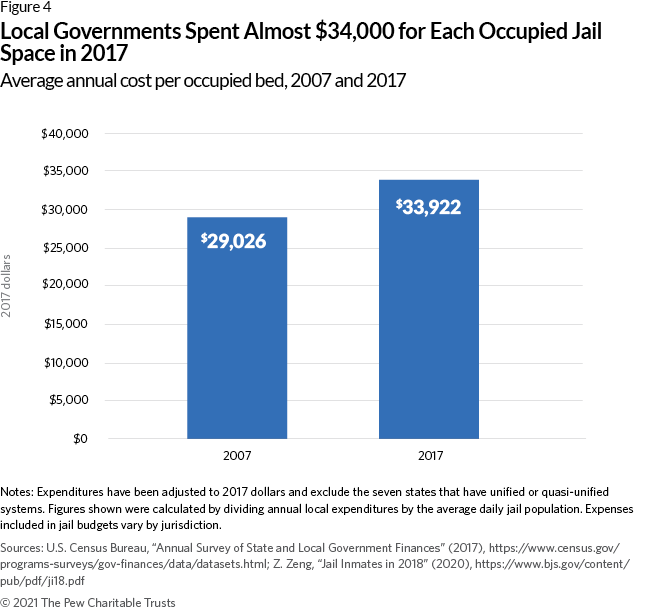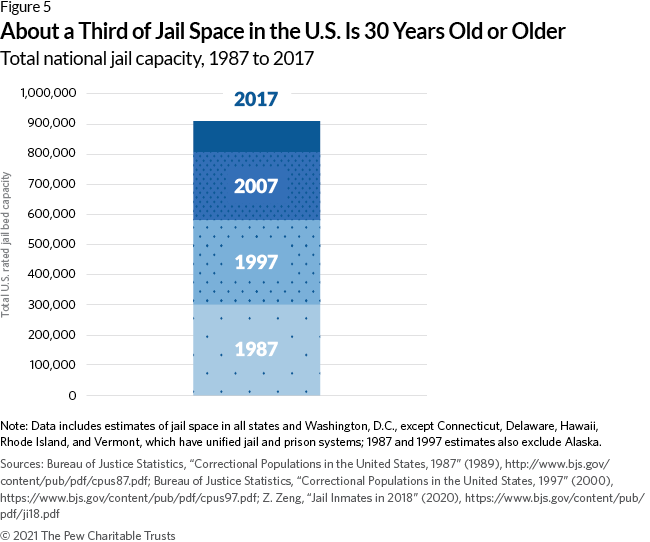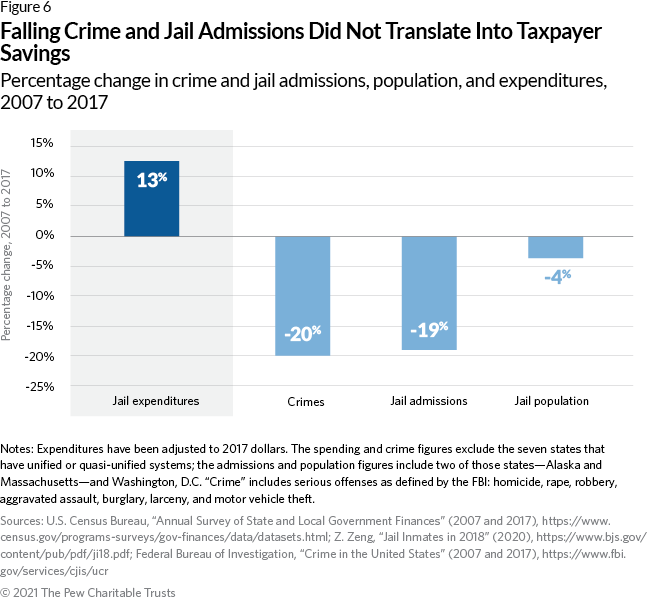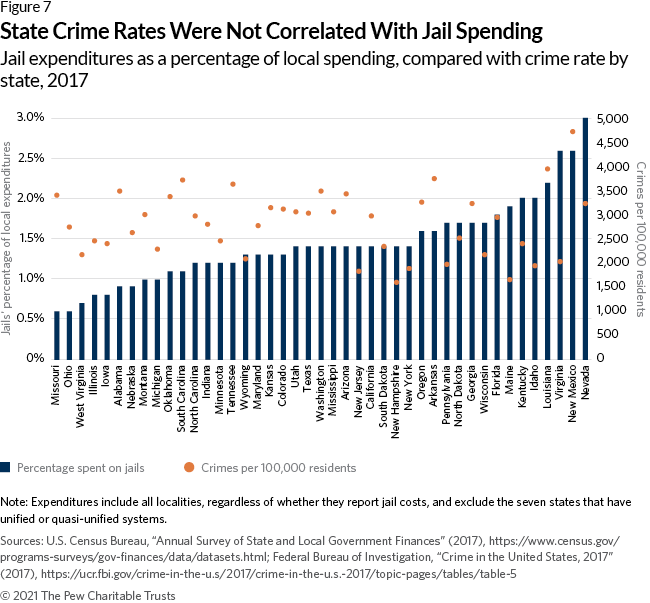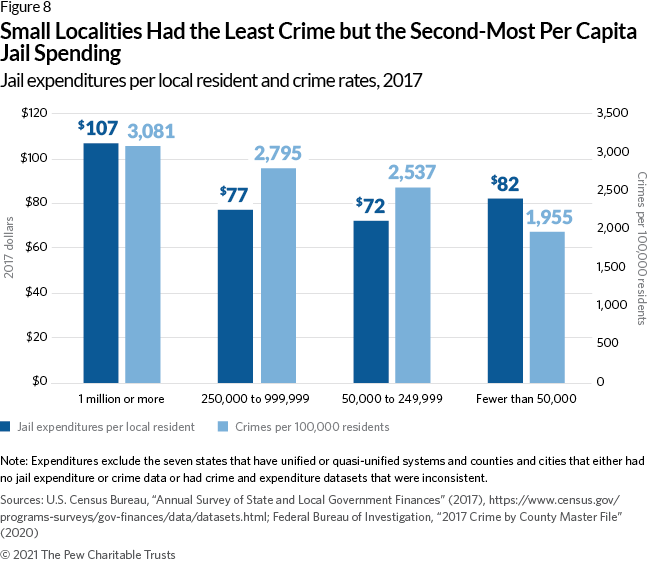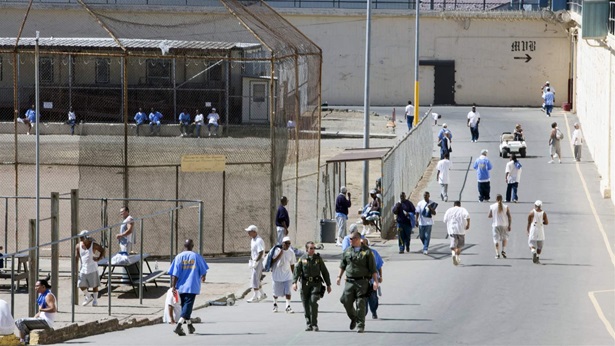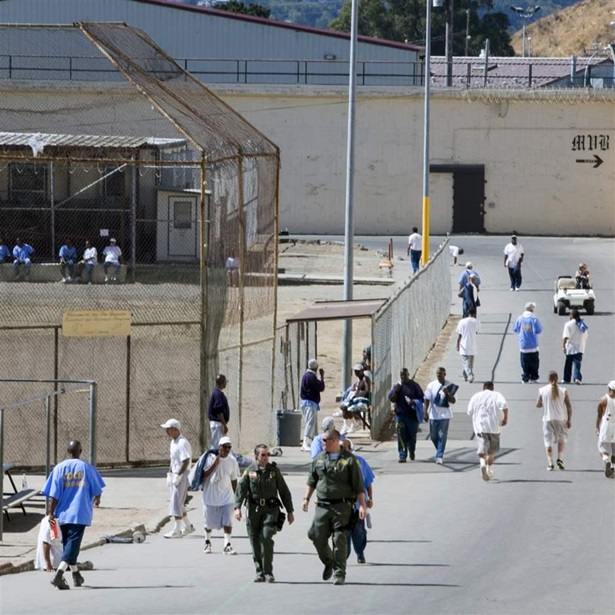Local Spending on Jails Tops $25 Billion in Latest Nationwide Data
Costs increased despite falling crime and fewer people being admitted to jail
Overview
Historically, the roughly 3,000 local jails operating in the United States have received less public and policymaker attention than prisons.1 But now, the COVID-19 pandemic has put jails—secure correctional facilities, generally operated by county or municipal governments, where people are detained before trial or confined post-conviction for periods usually lasting less than a year—under additional scrutiny.2 Jails rely on close confinement and so are high risk for disease transmission.3 Local governments are also confronting the budget implications of the pandemic and looking for potential savings, especially in costly areas such as corrections.4
This environment provides an opportunity to examine correctional expenditures and consider strategies that may offer enduring public safety and fiscal benefits.5 The available data indicates that to mitigate COVID-19 exposure risk, jurisdictions reduced jail populations by about 31% nationwide from March to May 2020, and although those populations partially rebounded, they were still 15% below March levels as of October 2020.6 Further, people released from jail in March were readmitted less often over the ensuing six months than those released in January, suggesting that the pandemic-related decreases in jail populations did not affect public safety. These reductions may not yield immediate savings, but a sustained commitment to safely cutting the number of people in jail could provide long-term financial benefits. The recent experience of reducing prison populations offers a glimpse of the potential cost savings: The 9% drop in the prison population from 2008 to 2018 virtually flattened corrections spending, which had averaged 5.4% annual growth from 1991 to 2007.7
To support state and local efforts to reduce jail spending and protect public safety, The Pew Charitable Trusts undertook an analysis of jail costs, using expenditure data for all U.S. localities, primarily from 2007 and 2017, and related criminal justice data. (See methodology for details on definitions and analyses.) Key findings include:
Local governments spend billions on jails. As of the end of 2017:
- Jail and other local corrections costs had risen sixfold since 1977, with jail costs reaching $25 billion.
- Almost 2 in 5 dollars spent on state and local correctional institutions went to jails.
- About 1 in 17 county dollars was spent on jails.
- The average annual cost of holding a person in jail was about $34,000.
- Roughly a third of jail facility capacity was more than 30 years old, and about 20% of jails were overcrowded, which could present significant capital challenges to local budgets.
Jail costs rose even as crime and admissions to jail fell. As of the end of 2017:
- A 20% decrease in crime and a 19% drop in jail admissions since 2007 had not led to reduced jail spending.
- The portion of local budgets spent on jails did not correlate with state crime rates.
- Small localities spent more per capita on jails than most other jurisdictions, despite having lower crime rates.
Nationwide, counties and cities are seeking to address budgetary pressures during these difficult fiscal times and for the long term. New policies and practices—including many they already have embraced in response to the pandemic—can safely reduce jail populations and associated costs and help them achieve those goals.
In 2017, local governments spent 521% more on corrections than they did in 1977.
Jail costs were 13% higher in 2017 than 2007, rising from $22 billion to $25 billion and outpacing the increase in total local expenditures for all spending categories (9%)8. During that same span, jails accounted for roughly 84 cents of every local government dollar spent on corrections.
The share of total local corrections spending that went toward jails before 2007 is unknown because jail costs were combined in the data with other local corrections expenditures until 2005.
Jails accounted for 39% of all nonfederal correctional institution expenditures in 2017. The rest went to state institutions such as prisons, which generally house people sentenced to a year or more.
The share of correctional funds spent on jails varied by state in 2017. State policies—such as who may be detained in jail or allowed bail, when probation or parole supervision can be revoked, and the length of sentences imposed for particular offenses—can influence the number of people incarcerated in local jails and the costs to taxpayers.9
States and institutions also differ in the types of spending they categorize as prison and jail expenditures.10 For example, some jurisdictions’ correctional budgets include health care costs, which can consume as much as a third of corrections dollars.11
Counties that operate jails spent roughly 6% of their local funds, or 1 in 17 dollars, on jails in 2017, making jails their sixth-largest expense category.12 Jails consumed about a third of all county public safety dollars.
About 1 in 5 counties does not operate a jail; some jails are shared regionally, while some are run by cities or states.13
The average annual cost of a year in jail was about $34,000 per person in 2017, an increase of 17% from 2007.
Operating expenses such as personnel, utilities, and health care made up 97% of jail costs. Employment expenditures accounted for roughly half of total corrections costs in 2007 and 2017.14
Some jail costs can be reduced with any decline in population; these include big-ticket items such as health care. However, jails also carry significant fixed expenses, such as utilities, that are the same regardless of how many people are in a jail facility.15
Between 1987 and 1997, as the nation’s jail population increased 92%, states and localities added almost 300,000 jail beds.16
As of 2017, about 30% of local jails were at least 30 years old. Research shows that jail infrastructure can degrade substantially after 30 to 40 years of wear and tear.17 Further, 20% of jails were operating over capacity in 2017.18
Jurisdictions with older or insufficient jails may need to consider jail construction in coming years, which is likely to carry significant costs.19 As of 2009, new jail construction was estimated to cost about $100,000 per bed space.20
Reducing jail populations could curb the need to add jail beds and allow outdated facilities to be decommissioned, potentially saving taxpayers millions of dollars.21
Jail spending increased 13% between 2007 and 2017, even though 2 million fewer crimes were reported to law enforcement in 2017 than 10 years earlier.22 During that same span, jail admissions dropped 19%, from 13.1 million to 10.6 million, and the average daily jail population declined by 4%, or 27,500 people.23
However, jail populations were relatively stagnant between 2007 and 2017 because the average number of days spent in jail increased from 22 to 26 during that period, which largely offset the decrease in admissions.24
Across states, the percentage of local expenditures going to jails varied and was not significantly related to crime rates in 2017.25 Jail spending accounted for between 0.6% and 3.0% of total local spending in each state.
Residents of some states with lower crime rates spent more of their local budgets on jails than those in states with higher crime rates. For example, Nevada and Missouri were at opposite ends of the spectrum in jail spending despite having similar crime rates, while in California and New Jersey, communities spent roughly the same share of their budgets, despite divergent state crime rates.
The Bureau of Justice Statistics has not produced state-level jail admission or population data since 2013.26 Such data could potentially show differences in admissions, populations, or lengths of stay in jail that might explain cost variations across states.
When comparing localities by size, jurisdictions with populations of less than 50,000 people, which are generally more rural, had the lowest crime rate but paid the second-highest amount per resident on jails. The crime rate for these jurisdictions was a third lower than that of the largest jurisdictions—those with more than a million residents.
Jails with fewer than 250 people confined, which are often in smaller jurisdictions, saw a 7% increase in population from 2007 to 2017, but their capacity increased by 17%, or just over 30,000 beds.27
Additionally, jail populations are growing in rural counties, and research suggests that this trend may be driven by sharp increases in rates of pretrial incarceration.28
Conclusion
Nationwide, crime and jail admissions decreased between 2007 and 2017, yet spending on jails increased 13%, to $25 billion, over that same span, consuming almost 1 in 17 local budget dollars. Although prisons have been the major focus of corrections budget discussions in the past, the cost of jails may face increased scrutiny as counties and municipalities face mounting fiscal pressures from the economic downturn associated with COVID-19.
Safely cutting jail costs could provide needed budget relief for local jurisdictions in the coming months and years, and a key strategy to reduce jail spending is further lowering jail populations. By continuing and expanding on policies that already have lowered confined populations during the pandemic, public officials can downsize their jail systems and potentially decommission older facilities, delivering meaningful taxpayer savings and protecting public safety.
Appendix: Methodology
This chartbook primarily uses data from the Census Bureau’s Annual Survey of State and Local Finances, the FBI’s Uniform Crime Reports (UCR), and “Jail Inmates in 2018” from the Bureau of Justice Statistics (BJS).29
The Annual Survey of State and Local Finances
The survey is the only uniform nationwide dataset on government finances and provides information on expenditures, revenue, assets, and debts for all 50 states and Washington, D.C., organized by government function.30 Census data is collected every five years (those ending in “2” or “7”); annual data is collected from a sample of localities for all other years.31
The Census Bureau categorizes spending into functions; only direct expenditures—external payments made by local or state governments from their own revenue—were included in this analysis. Direct expenditures cover current operations, construction, land and existing structures, equipment, and assistance and subsidies, if applicable. Intergovernmental transfers—money paid to other governments for functions such as housing people in jails—also were excluded.
The Census Bureau provides five “correctional institution” function codes for direct jail expenditures: F04: Land and Existing Structures, G04: Construction, J04: Assistance and Subsidies, and K04: Equipment.32 Equipment applies to states and the federal government, while assistance and subsidies is applicable only to the federal government. The Census Bureau provides separate data for state-level expenditures (i.e., state prisons) and county, city, municipality, and township-level spending (i.e., local jails). For the purposes of this study, all categories are considered cities, except counties. Since 2005, correctional institution expenditures have not included local community supervision functions such as probation and parole, which now fall under the “Other Corrections” category. Before 2005, the census measured all local corrections costs—correctional institutions and supervision—under the “Other Corrections” category.
In line with past research using this data, all expenditures were adjusted to 2017 constant dollars using chain-type price indices for gross domestic product from the 2019 Economic Report of the President, Table B-5.33 Although the census standardizes expenditures as much as possible, the types of spending included in reported jail expenditures are not necessarily uniform across jails or states. This report did not attempt to consider such variations in reported expenses. For example, reported figures do not indicate the extent to which costs such as health care for people confined in jail are included in some counties but not others; additionally, jail spending as a portion of all local expenditures depends on what else—for instance, K-12 education—is part of each locality’s budget. Expenditures presented in Figure 1 were rounded to the nearest $1 billion. All other amounts were rounded to the nearest whole dollar—or cents, if under $1. Percentages and percentage differences were calculated with unrounded numbers and then rounded to the nearest whole percentage.
Uniform Crime Reports
The UCR provides yearly estimates of serious violent and property crimes (homicide, rape, robbery, aggravated assault, burglary, larceny, and motor vehicle theft) reported to law enforcement at the national, state, and local levels.34 Although the UCR expanded its definition of rape in 2013, the estimates in this chartbook use the “legacy” definition for all years to ensure comparability over time.35
Jail Inmates in 2018
The BJS analyzes and compares data from the Annual Survey of Jails (ASJ), a nationally representative review that estimates the number of individuals admitted to jail and the average daily population (ADP) in jail for various years.36
National and state-level analyses
Data cleaning
The Census Bureau provides pre-aggregated state and local-level expenditures for each state in the national and state-level analyses. For this chartbook, the researchers included data from 43 states. Seven states were eliminated based on the nature of their jail systems. Six states—Alaska, Connecticut, Delaware, Hawaii, Rhode Island, and Vermont—operate unified systems in which spending on jail and prison systems is integrated. In these cases, expenditures for the different institution types cannot be separated.37 Similarly, Massachusetts has a “quasi-unified” system and has not reported local jail spending to the Census Bureau since 2007.38 Washington, D.C.; Puerto Rico; and other nonstate jurisdictions were excluded except where otherwise noted.
Because of data collection processes, “Jail Inmates in 2018” primarily covers nonunified states; it excludes Connecticut, Delaware, Hawaii, Rhode Island, and Vermont but includes Alaska, Massachusetts, and D.C.39 Further, state-level jail estimates are not provided because the ASJ sample is designed for national-level estimation only. Supplemental analysis of the most recent Census of Jails, which includes all jails, shows that nonunified states accounted for roughly 99% of jail jurisdictions, yearly jail admissions, and ADP in 2013.40
Calculating cost per occupied jail space
Pew’s researchers calculated the average yearly cost per occupied jail space by dividing the annual jail expenditures by the ADP.
Comparing jail expenditures and crime
When analyzing national and state-level jail spending and crime, census and UCR population data was matched to ensure similar coverage and was found to have less than a 7% difference in estimated resident populations for each state for all years included.
County and city-level analyses
Data cleaning
The county and city analyses relied on discrete rather than pre-aggregated local-level census data. Counties are primarily responsible for operating jails, and the original census data included 3,029 counties in all states and D.C. Pew researchers first eliminated jurisdictions in the unified and quasi-unified states—Alaska, Connecticut, Delaware, Hawaii, Massachusetts, Rhode Island, and Vermont—and D.C., which together account for 41 counties. Another 97 counties, including all localities in Virginia, were excluded because they rely entirely or primarily on regional jails for which operations responsibilities are shared among multiple counties.41
Some counties have multiple jails, and some are home to cities or special districts that operate jails.42 A city jail is funded by the city, whereas the Census Bureau considers special district jails independent governments. Because special districts may be operated by more than one county or city, localities associated with these jails (five counties and three cities) were also eliminated from the analysis. Finally, 591 counties in the remaining sample did not operate jails and were also omitted. Many of the counties without jail expenditures make intergovernmental payments to other localities to house people in jails.
After these data reductions, 2,295 counties and 660 cities remained that had at least one direct jail expenditure function code. The county analysis comparing local costs includes all 2,295 counties.
Calculating crime information by population group
Because counties could include more than one jail or contain cities or municipalities that operate jails, all remaining cases were aggregated to the parent county level or to the city level if the listed parent county did not operate a jail. Aggregation yielded 2,955 jail expenditure codes representing 2,375 unique cities and counties (“baseline data”). Based on the most recent Census of Jails, 2,931 local jails operated within 2,685 jurisdictions nationwide in 2013, although jurisdictions may not correspond directly to the Census Bureau’s classification of counties or cities.43
To compare crime information, Pew researchers obtained local-level UCR data directly from the FBI, but information was not available for all 2,375 localities. To ensure comparability across datasets, an additional 71 localities were eliminated from this analysis because they did not have matches in the UCR data.
Like the state-level analyses, local population estimates from UCR and the Census Bureau were compared to ensure similar coverage. First, 43 localities that did not have a population estimate in the UCR data were dropped. Second, because the population size groups were of primary importance in this analysis, 52 counties or cities that did not fall into the same population size category in both the UCR and the census datasets were also eliminated. Additionally, 198 other localities that had inconsistencies among the UCR and census population estimates (those that were more than 10% different) were removed. These exclusions resulted in 2,011 unique localities for use in comparing jail spending and crime rate at the county and city level, grouped by population (“reduced county and city data”). Because the census and UCR data contain local population estimates, per-local-resident jail spending was calculated using the census population estimate, while crime per 100,000 local residents was calculated using the UCR estimate.
Table A.1
Baseline and Reduced County and City 2017 Data
|
Baseline county and city data |
Reduced county and city data |
|||||
|---|---|---|---|---|---|---|
| Population group | Locality count | Total population | Per-local-resident jail expenditures | Locality count | Total population | Per-local-resident jail expenditures |
| 1 million or more | 39 | 88,912,201 | $106 | 33 | 80,978,514 | $107 |
| 250,000 to 999,999 | 190 | 93,257,869 | $79 | 179 | 86,886,441 | $77 |
| 50,000 to 249,999 | 602 | 66,116,565 | $71 | 537 | 58,863,118 | $72 |
| Less than 50,000 | 1,544 | 30,498,988 | $81 | 1,262 | 25,495,458 | $82 |
Sources: U.S. Census Bureau, “Annual Survey of State and Local Government Finances” (2007 and 2017), https://www.census.gov/programs-surveys/gov-finances/data/datasets.html; Federal Bureau of Investigation, “2017 Crime by County Master File” (2020)
© 2020 The Pew Charitable Trusts
Endnotes
- T.D. Minton et al., “Census of Jails: Population Changes, 1999-2013” (Bureau of Justice Statistics, 2015), https://www.bjs.gov/content/pub/pdf/cjpc9913.pdf; C. Henrichson, J. Rinaldi, and R. Delaney, “The Price of Jails: Measuring the Taxpayer Cost of Local Incarceration” (Vera Institute of Justice, 2015), https://www.vera.org/downloads/publications/price-of-jails.pdf.
- Z. Zeng, “Jail Inmates in 2018” (Bureau of Justice Statistics, 2020), https://www.bjs.gov/content/pub/pdf/ji18.pdf; E. Reinhart and D.L. Chen, “Incarceration and Its Disseminations: COVID-19 Pandemic Lessons From Chicago’s Cook County Jail,” Health Affairs 39, no. 8 (2020): 1412-18, https://www.healthaffairs.org/doi/10.1377/hlthaff.2020.00652.
- Reinhart and Chen, “Incarceration and Its Disseminations: COVID-19 Pandemic Lessons.”
- A. Siripurapu and J. Masters, “How the Coronavirus Will Harm State and City Budgets” (Council on Foreign Relations, 2020), https://www.cfr.org/backgrounder/how-coronavirus-will-harm-state-and-city-budgets.
- P.V. McHarris and T. McHarris, “No More Money for the Police,” The New York Times, May 30, 2020, https://www.nytimes.com/2020/05/30/opinion/george-floyd-police-funding.html.
- A. Harvey, O. Taylor, and A. Wang, “COVID-19, Jails, and Public Safety” (Council on Criminal Justice, 2020), https://cdn.ymaws.com/counciloncj.org/resource/resmgr/covid_commission/covid-19,_jails,_and_public_.pdf.
- L.M. Maruschak and T.D. Minton, “Correctional Populations in the United States, 2017-2018” (Bureau of Justice Statistics, 2020), https://www.bjs.gov/content/pub/pdf/cpus1718.pdf; National Association of State Budget Officers, “1991-2019 State Expenditure Report Data” (2019), https://www.nasbo.org/mainsite/reports-data/state-expenditure-report/ser-download-data.
- “Local expenditures” refers to direct spending only and excludes intergovernmental transfers. See methodology for additional details.
- National Conference of State Legislatures, “State Policies Affecting Local Jails,” accessed Sept. 29, 2020, https://www.ncsl.org/research/civil-and-criminal-justice/state-policies-affecting-local-jails.aspx; R. Williams, “Bail or Jail,” State Legislatures Magazine (May 2012), https://www.ncsl.org/research/civil-and-criminal-justice/bail-or-jail.aspx; The Pew Charitable Trusts, “To Safely Cut Incarceration, States Rethink Responses to Supervision Violations” (2019), https://www.pewtrusts.org/en/research-and-analysis/issue-briefs/2019/07/to-safely-cut-incarceration-states-rethink-responses-to-supervision-violations; D.M. Bennett and D. Lattin, “Jail Capacity Planning Guide: A Systems Approach” (National Institute of Corrections, 2009), https://info.nicic.gov/nicrp/system/files/022722.pdf.
- Henrichson, Rinaldi, and Delaney, “The Price of Jails.”
- Ibid.; The Pew Charitable Trusts, “Jails: Inadvertent Health Care Providers” (2018), https://www.pewtrusts.org/en/research-and-analysis/reports/2018/01/jails-inadvertent-health-care-providers.
- In some jurisdictions, independent school districts may be responsible for some or all K-12 education expenses; 2,752 counties in the Annual Survey of State and Local Finances reported independent school districts in 2017, which accounted for almost $523 billion in K-12 expenditures.
- Although it is unclear from the data whether these counties without jail expenditures are paying intergovernmental costs to other jurisdictions to operate jails/house their local correctional population or are part of a regional jail system, roughly 21% of the sample counties did not include direct jail expenditure functions in their Annual Survey of State and Local Finances data.
- U.S. Census Bureau, Annual Survey of Public Employment and Payroll, 2017, https://www.census.gov/programs-surveys/apes/data/datasetstables/2017.html. The Census Bureau does not provide more detailed information on expenditure categories, with the exception of correctional employment, which includes jail staff as well as local community supervision officers.
- Henrichson, Rinaldi, and Delaney, “The Price of Jails.”
- Bureau of Justice Statistics, “Correctional Populations in the United States, 1987” (1989), http://www.bjs.gov/content/pub/pdf/cpus87.pdf; Bureau of Justice Statistics, “Correctional Populations in the United States, 1997” (2000), https://www.bjs.gov/content/pub/pdf/cpus97.pdf.
- Bennett and Lattin, “Jail Capacity Planning.”
- Z. Zeng, “Jail Inmates in 2017” (Bureau of Justice Statistics, 2019), https://www.bjs.gov/content/pub/pdf/ji17.pdf.
- C. Mai et al., “Broken Ground: Why America Keeps Building More Jails and What It Can Do Instead” (Vera Institute of Justice, 2019), https://www.vera.org/downloads/publications/broken-ground-jail-construction.pdf.
- D.A. Kimme, G.M. Bowker, and R.G. Deichman, “Jail Design Guide” (National Institute of Corrections, 2011), https://s3.amazonaws.com/static.nicic.gov/Library/024806.pdf.
- Mai et al., “Broken Ground.”
- Federal Bureau of Investigation, “Crime in the United States” (2007 and 2017), https://www.fbi.gov/services/cjis/ucr.
- Zeng, “Jail Inmates in 2017.”
- Ibid.
- This analysis looks at jails as a percentage of all local expenditures to adjust for differences in cost of living between states. Correlations were tested using a Pearson statistic: crime rates and the portion spent on local jails: r = 0.09; p-value = 0.57; crime rates and the total spent on local jails: r = 0.13; p-value = 0.41. Subsequent analyses also found no correlation between jail expenditures per state resident and crime rates: r = -0.07; p-value = 0.66.
- Bureau of Justice Statistics, “Annual Survey of Jails, 2017 Codebook” (Inter-University Consortium for Political and Social Research, 2019), https://www.icpsr.umich.edu/web/NACJD/studies/37373#.
- W.J. Sabol and T.D. Minton, “Jail Inmates at Midyear 2007” (Bureau of Justice Statistics, 2008), https://www.bjs.gov/content/pub/pdf/jim07.pdf; Z. Zeng, “Jail Inmates in 2017” (Bureau of Justice Statistics, 2019), https://www.bjs.gov/content/pub/pdf/ji17.pdf.
- J. Kang-Brown and R. Subramanian, “Out of Sight: The Growth of Jails in Rural America” (Vera Institute of Justice, 2017), https://www.vera.org/downloads/publications/out-of-sight-growth-of-jails-rural-america.pdf.
- U.S. Census Bureau, “Annual Survey of State and Local Government Finances” (2007 and 2017), https://www.census.gov/programs-surveys/gov-finances/data/datasets.html; Federal Bureau of Investigation, “Crime in the United States”; Zeng, “Jail Inmates in 2018.”
- U.S. Census Bureau, “About: Annual Survey of State and Local Government Finances,” accessed June 30, 2020, https://www.census.gov/programs-surveys/gov-finances/about.html.
- U.S. Census Bureau, “Government Finance and Employment Classification Manual” (2006),40 http://www2.census.gov/govs/pubs/classification/2006_classification_manual.pdf.
- Ibid.
- E. Herberman and T. Kyckelhahn, “State Government Indigent Defense Expenditures, FY 2008-2012–Updated” (Bureau of Justice Statistics, 2015), https://www.bjs.gov/content/pub/pdf/sgide0812.pdf; Council of Economic Advisers, Executive Office of the President of the United States, “Economic Report of the President” (2019), https://www.whitehouse.gov/wp-content/uploads/2019/03/ERP-2019.pdf.
- Federal Bureau of Investigation, “Uniform Crime Report: Offenses Known to Law Enforcement” (2019), https://ucr.fbi.gov/crime-in-the-u.s/2018/crime-in-the-u.s.-2018/topic-pages/offenses-known-to-law-enforcement.pdf.
- Federal Bureau of Investigation, “Uniform Crime Report: Rape” (2019), https://ucr.fbi.gov/crime-in-the-u.s/2018/crime-in-the-u.s.-2018/topic-pages/rape.pdf.
- Zeng, “Jail Inmates in 2018.”
- National Institute of Corrections, “A Review of the Jail Function Within State Unified Corrections Systems” (National Institute of Justice, 1997), https://nicic.gov/sites/default/files/014024.pdf.
- U.S. Census Bureau, State and Local Government Finance Historical Datasets and Tables, 2007 and 2017, accessed July 16, 2020, https://www.census.gov/programs-surveys/gov-finances/data/datasets.html.
- Bureau of Justice Statistics, “Annual Survey of Jails, 2018 Codebook” (Inter-University Consortium for Political and Social Research, 2020), https://www.icpsr.umich.edu/web/NACJD/studies/37392.
- Bureau of Justice Statistics, “Census of Jails, 2013” (Inter-University Consortium for Political and Social Research, 2018), https://www.icpsr.umich.edu/web/NACJD/studies/36128.
- Virginia Department of Education, “Virginia’s Local and Regional Jails Directory” (2016), http://www.doe.virginia.gov/special_ed/iep_instruct_svcs/jail_program/jail_directory.pdf.
- U.S. Census Bureau, “Government Finance and Employment Classification Manual.” The Census Bureau reports data from counties, cities, municipalities, and townships; for the purposes of this study, all categories except counties are considered cities.
- Minton, “Census of Jails: Population Changes, 1999-2013.”

